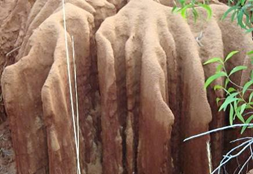

03 December 2022 (7 Topics)
Context
Geologists have said that the coastal red sand dunes of Vizag, have much significance geologically, archaeologically, and anthropologically and it needs to be protected.
About
About Coastal red sand dunes
- Coastal red sand dunes are popularly known as Erra Matti Dibbalu.
- It is dissected and stabilized coastal red sediment mounds, located between Visakhapatnam and Bheemunipatnam in Andhra Pradesh.
- They have very low water and nutrient retention capacity.
- The dunes are susceptible to aerodynamic lift. This is the push that lets something move up. It is the force that is the opposite of weight.

What gave the sand its unique red color?
- During that late Quaternary period, the sea level rose to as much as 150 feet and fell away a number of times to the current level.
- Between these oscillating sea levels, the coast was submerged and exposed over and over again, huge volumes of clay, silt, and sand covered the coast from where the sea water had receded.
|
Other Similar Places: Such sand deposits are rare and have been reported only from three places in the tropical regions in south Asia such as:
|
- Due to the extreme changes in climatic conditions, the material under the sandy dunes “baked” in the sun like a brick gets baked in a kiln leading to the peculiar red sand dunes.
Recognition:
- This site was declared a geo-heritage site by the Geological Survey of India (GSI) in 2014.
- The Andhra Pradesh government listed it under the category of ‘protected sites’ in 2016.
Significance:
- They are geologically important as they represent the geological history of the late Quaternary period (2.6 million years ago to the present).
- They carry the imprints of the fall of sea level and its subsequent rise, the impact of climate, monsoon, and geological processes on the sediments.
- They are anthropologically and archeologically important as they possibly contain Mesolithic and neolithic cultural materials as well.
- The site is about 18,500 to 20,000 years old and it can be related to the last glacial period.
- It needs to be protected for further study of the impact of climate change, as Erra Matti Dibbalu has seen both the glacial and the warm periods.
|
Geological Survey of India
|
More Articles



